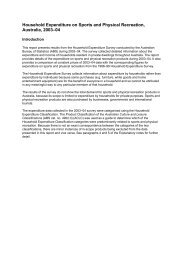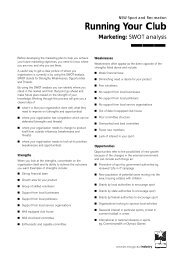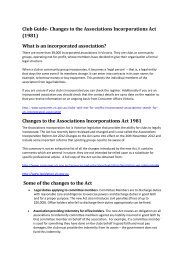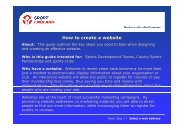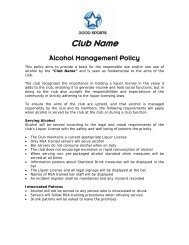Can You Risk It? - Insurance Commission of Western Australia
Can You Risk It? - Insurance Commission of Western Australia
Can You Risk It? - Insurance Commission of Western Australia
You also want an ePaper? Increase the reach of your titles
YUMPU automatically turns print PDFs into web optimized ePapers that Google loves.
<strong>Can</strong> <strong>You</strong> <strong>Risk</strong> <strong>It</strong>?AN INTRODUCTION TORISK MANAGEMENT FORCOMMUNITY ORGANISATIONSIncludes Community <strong>Risk</strong>Base User’s GuideA risk management initiative <strong>of</strong> the Government <strong>of</strong> <strong>Western</strong> <strong>Australia</strong>
<strong>Can</strong> <strong>You</strong> <strong>Risk</strong> <strong>It</strong>?AN INTRODUCTION TORISK MANAGEMENT FORCOMMUNITY ORGANISATIONSIncludes Community <strong>Risk</strong>Base User’s Guide
ACKNOWLEDGEMENT<strong>Risk</strong>Cover acknowledges the Department <strong>of</strong> Sport and Recreation for thevaluable assistance it has provided in the preparation <strong>of</strong> this resource.First edition May 2003Second edition May 2004Third Edition February 2007ISBN 0-9750400-7-3Enquiries or comments on the contents <strong>of</strong> this resource can be directed to:<strong>Risk</strong> Management Services<strong>Risk</strong>Cover<strong>Insurance</strong> <strong>Commission</strong> <strong>of</strong> WA8th Floor, The Forrest Centre221 St Georges Terrace, Perth <strong>Western</strong> <strong>Australia</strong> 6000Telephone (08) 9264 3333Freecall (Country Areas) 1800 643 338www.icwa.wa.gov.auSome images kindly supplied by the Albany Advertiser Pty Ltd.
ContentsIntroduction 1Definitions 2Why do we need to manage risk? 2When do we need to manage risk? 3<strong>Risk</strong> Management Process 3Step 1 – Establish the context 4Step 2 – <strong>Risk</strong> identification 5Step 3 – <strong>Risk</strong> assessment 5Step 4 – <strong>Risk</strong> treatment and control 6Step 5 – Monitoring and review 6Relevant Legislation 7More information 9Attachment A 10Qualitative Measures <strong>of</strong> Consequences 10Qualitative Measures <strong>of</strong> Likelihood 10Sample <strong>Risk</strong> Criteria 10Attachment B 11Sample risk identification form 11<strong>Risk</strong>s by Level <strong>of</strong> <strong>Risk</strong> 12<strong>Risk</strong>s by Level <strong>of</strong> <strong>Risk</strong> Worksheet 13Community <strong>Risk</strong>Base User’s GuideIntroduction 17Using your Community <strong>Risk</strong>Base package 18Main Menu Screen 191. Open Data Entry Form 202. Report – <strong>Risk</strong>s by Level <strong>of</strong> <strong>Risk</strong> 223. Report – <strong>Risk</strong>s by Action 234. Report – <strong>Risk</strong>s by Activity/Event 24Report Sample – <strong>Risk</strong>s by Activity/Event 245. Edit Consequence Categories and Likelihood Tables 25To Change Consequence Definition 25To Change Likelihood Frequency: 26Case Study 27
Introduction<strong>Risk</strong> management is all about being aware <strong>of</strong> what may happen as you go about your businessand taking steps to limit the chances <strong>of</strong> something going wrong, or deciding that you acceptthat something may occur and that you are prepared for the consequences.<strong>Risk</strong> management is not necessarily something new. <strong>You</strong> undertake risk management every day. Putting awaythe hose after watering the garden to avoid tripping over it later is an example <strong>of</strong> risk management. Activatingthe immobiliser on the car to prevent it from being stolen is another example <strong>of</strong> risk management.However, the emphasis now is on organisations like undertaking a structured approach to riskmanagement to demonstrate to insurers and others that you have a transparent process whichshows how you reached a decision whether to accept or not to accept certain risks.<strong>It</strong> also gives you a systematic approach to identify and manage key risk exposures so thatyou can direct your resources towards the area where they will be most effective.The State Government has introduced a number <strong>of</strong> initiatives to address the publicliability crisis, including the following signifi cant pieces <strong>of</strong> legislation:• the Volunteers (Protection from Liability) Act 2002 which protects volunteersfrom personal liability when performing community work;• the Fire and Emergency Services Legislation Amendment Act 2002 which extends protectionfrom personal liability to volunteer emergency workers and their organisations;• the Civil Liability Act 2002 which creates a fairer and more predictable legislative environment;• the Civil Liability Amendment Bill 2003 which helps to change social and legalattitudes towards the assumption <strong>of</strong> and liability for risk; and• the <strong>Insurance</strong> <strong>Commission</strong> <strong>of</strong> <strong>Western</strong> <strong>Australia</strong> (Amendment) Act 2002 which enablesgovernment to provide insurance cover to eligible community organisations.As well as being good practice, an effective risk management program is a positivestrategy for organisations to identify those unexpected and costly surprises.This resource provides an easy to understand guide to implementing your own risk management program.1 <strong>Can</strong> <strong>You</strong> <strong>Risk</strong> <strong>It</strong>? An Introduction to <strong>Risk</strong> Management for Community Organisations
DEFINITIONSWHAT IS RISK MANAGEMENT?The culture, processes and structures that are directed towards the effectivemanagement <strong>of</strong> potential opportunities and adverse effects. 1WHAT IS RISK?The chance <strong>of</strong> something happening that will have an impact upon objectives. <strong>It</strong> is measured interms <strong>of</strong> likelihood and consequences or in other words the risk event/incident/accident that mighthappen and prevent you from successfully completing what it is you are setting out to do.WHAT DOES RISK REDUCTION MEAN?A selective application <strong>of</strong> appropriate techniques and management principles toreduce either likelihood <strong>of</strong> an occurrence or its consequences or both.WHAT IS RISK TRANSFER?Shifting responsibility or burden for loss to another party through legislation, contract, insurance or other means.WHAT DOES RISK ACCEPTANCE MEAN?An informed decision to accept the consequences and the likelihood <strong>of</strong> particular risk.WHAT IS A RISK REGISTER?A tool used to record information derived from performing a risk management process.WHY DO WE NEED TO MANAGE RISK?<strong>It</strong> is simply good management practice. <strong>It</strong> also provides structure and form to your decision-making processes.Some good reasons to manage risks include:• Helps with strategic planning• Reduces unexpected and costly surprises• More effective and effi cient allocation <strong>of</strong> resources• Better results from projects and programs• Assists you to clearly defi ne insurance needs• Better information for decision-making• Compliance with regulatory requirements• Assists in preparation for auditing• Lessening risk encourages more people to participate in your activity• Balancing opportunity and risk• Assist you to obtain insurance cover.1All defi nitions derived from The <strong>Australia</strong>n/New Zealand Standard for <strong>Risk</strong> Management (AS/NZS 4360)<strong>Can</strong> <strong>You</strong> <strong>Risk</strong> <strong>It</strong>? An Introduction to <strong>Risk</strong> Management for Community Organisations 2
WHEN DO WE NEED TO MANAGE RISK?<strong>Risk</strong> management is a way <strong>of</strong> looking at your operations by considering whatcan stop you from achieving what you want to achieve.Therefore, risk management is an ongoing process that you apply to all aspects <strong>of</strong> your operations.<strong>You</strong> should carry out a risk assessment for any new project, event or initiative. <strong>It</strong> is a continuousprocess that is designed to help you prioritise where you dedicate your resources and funds.RISK MANAGEMENT IS A FIVE STEP PROCESSSTEP 1STEP 2STEP 3STEP 4STEP 5Establish the contextIdentify riskAssess risksTreat risksOngoing monitoring and reviewIMPORTANTThroughout each step it is essential that there is consultation and communicationwith everyone in your organisation’s functions, activities and events.RISK MANAGEMENT PROCESSCommunicate and Consult(ongoing throughout all steps)Step 4 Step 3 Step 2 Step 1Establish the contextIdentify risksAnalyse risksEvaluate risksTreat risksStep 5MonitorandReview3 <strong>Can</strong> <strong>You</strong> <strong>Risk</strong> <strong>It</strong>? An Introduction to <strong>Risk</strong> Management for Community Organisations
Step 1 – Establish the contextTo effectively identify your risks, you need to take into account your own objectivesand capabilities as well as factors external to your organisation.There are two elements to this step:1. OVERALL PROGRAM ISSUES:Dealing with those matters regarding measures to be used in the process.• The scope <strong>of</strong> risk management within your organisation.• The aims and objectives <strong>of</strong> your own risk management program in relation to your organisation.• The who, what, when, how and with what resources?• Determine criteria for treating risks.• Defi ne the extent and comprehensiveness <strong>of</strong> the risk management activities.• Defi ne your risk assessment criteria table.• Defi ne your risk acceptance criteria.2. RISK ASSESSMENT SPECIFIC ISSUES:Establishing the boundaries for each specifi c risk assessment.• Defi ne the project or activity for which you are going to identify risks.– defi ne functions or activities; or– project stages; or– event stages.Key activities can be categorised into three levels with associated risk:STRATEGIC<strong>Risk</strong>s associated with the high-level longer-term goals, objectives, orstrategies <strong>of</strong> the organisation, business, or association.OPERATIONAL<strong>Risk</strong>s associated with the daily functions <strong>of</strong> the organisation such as fi nance, decision-making,marketing and promotion and the administrative areas <strong>of</strong> your business, association.PROJECT/EVENTThose risks associated with a specifi c project or event including all phases <strong>of</strong> theevent. Concept, planning, implementation project/event operation.<strong>Can</strong> <strong>You</strong> <strong>Risk</strong> <strong>It</strong>? An Introduction to <strong>Risk</strong> Management for Community Organisations 4
Step 2 – <strong>Risk</strong> identificationThe purpose <strong>of</strong> this step is to identify what could go wrong and what could happento prevent you from successfully doing what it is you set out to do.METHODS• Experience and records: Start by reviewing your own and industry records for the types <strong>of</strong> eventsthat have happened in the past (this is only an indicator as not all risk events have happened).• Brainstorming: Get together with those who know your industry well to fi nd outwhat the business relies upon and the things that can—and do—go wrong.• Systems analysis: Analyse your business systems and processes to identify critical points.• Personal reports: Look up specialists’ reports or other internal reportsthat identify things that could affect your ability to succeed.• Audit and other recommendations: Look for audit fi ndings as they mayalso identify things that could affect your ability to succeed.KEY QUESTIONS• What can happen? List risks, incidents or accidents that might happen by systematically workingthrough each function, activity or stage <strong>of</strong> your event to identify what might happen at each stage.• How and why it can happen? List the possible causes and scenarios or description<strong>of</strong> the risk, incident or accident (refer to Attachment B for examples).5 <strong>Can</strong> <strong>You</strong> <strong>Risk</strong> <strong>It</strong>? An Introduction to <strong>Risk</strong> Management for Community Organisations
Step 3 – <strong>Risk</strong> assessmentThis involves analysing the likelihood and consequences <strong>of</strong> each identifi ed risk using themeasures provided. When multiplied you can work out the overall level <strong>of</strong> risk.The purpose <strong>of</strong> this step is to separate high risks from low risks, to prioritisethose areas where resources should be allocated.• Likelihood: This is a qualitative description <strong>of</strong> probability andfrequency. What is the likelihood <strong>of</strong> the risk occurring?• Consequence: This is the outcome <strong>of</strong> an event or situation expressed qualitatively or quantitatively,being a loss, injury, disadvantage or gain. What is the consequence <strong>of</strong> the risk event?(Refer to Attachment A for an example <strong>of</strong> likelihood and consequences).KEY QUESTIONS• Look at the adequacy <strong>of</strong> existing controls. Identify what you currently do to control this risk.• What are the consequences if it occurs?• How likely is it to occur? (Evaluate likelihood based on existing controls).• Multiply consequences by likelihood to give a level <strong>of</strong> risk.• Review the level <strong>of</strong> risk determined against the acceptance criteria identifi ed inStep One (refer to Attachment A for an example criteria table).• Decide which risks are to be treated or accepted. Decide this by identifying atwhat value a risk changes from being acceptable to unacceptable.(Refer to Attachment B for a sample risk identifi cation form and risk register— the tools you will use to record your analysis).<strong>Can</strong> <strong>You</strong> <strong>Risk</strong> <strong>It</strong>? An Introduction to <strong>Risk</strong> Management for Community Organisations 6
Step 4 – <strong>Risk</strong> treatment and controlIf a risk is identifi ed as high or unacceptable then you should evaluate what else you can doto reduce the risk by implementing new risk controls or enhancing existing controls.What are your choices?• Reduce the likelihood <strong>of</strong> the risk occurring• Reduce the consequences <strong>of</strong> the risk occurring• Accept the risk on the basis that you are doing all things reasonable• Avoid the risk by discontinuing this activity—don’t do it!• Transfer the risk by way <strong>of</strong> contract, insurance, etc.KEY QUESTIONS• What do you currently do to control this risk?• What resources will you require to implement the chosen treatment?• Is it worth doing? i.e. cost versus benefi t consideration.7 <strong>Can</strong> <strong>You</strong> <strong>Risk</strong> <strong>It</strong>? An Introduction to <strong>Risk</strong> Management for Community Organisations
Step 5 – Monitoring and review<strong>Risk</strong> management is an ongoing process, so you need to regularly review whether anythinghas changed which may impact on the risk issues you have identifi ed.<strong>You</strong> can do this by:• risk reviews;• review progress <strong>of</strong> new treatment plans; and• new risks can also be identifi ed from:– claims performance reports;– audits (internal and external) reports; and– physical inspections.<strong>Can</strong> <strong>You</strong> <strong>Risk</strong> <strong>It</strong>? An Introduction to <strong>Risk</strong> Management for Community Organisations 8
Relevant LegislationUndertaking a risk management process is an extremely positive strategy for your organisation tocommit to continuously improving. The state government has introduced a number <strong>of</strong> initiatives tocomplement your commitment to risk management in an effort to address the public liability crisis.VOLUNTEERS (PROTECTION FROM LIABILITY) ACT 2002• Someone who is volunteering for an incorporated not-for-pr<strong>of</strong>i t organisation and operatesin good faith when doing community work and within the organisation’s guidelines isprotected from personal civil liability under this Act, subject to certain exceptions.• The intent is that the liability will transfer to the community organisation with which they are involved.• This means that volunteers cannot be sued for something they did or failed to do, if they are actingwithin the scope <strong>of</strong> the work and directions given to them by the community organisation.For more information visit www.community.wa.gov.au/Communities/volunteers/PROTECTION THROUGH ASSOCIATIONS INCORPORATION ACT 1987• Incorporation creates a legal entity (the organisation) that is separate from the individual members.• The Associations Incorporation Act provides a level <strong>of</strong> protection to an individual member frombeing sued for the action <strong>of</strong> the association or <strong>of</strong> another member <strong>of</strong> the association.• The Act does not protect a member <strong>of</strong> an association from being sued for theirown actions, e.g. negligence or wrongful acts committed by them.• Members and committee or board members <strong>of</strong> unincorporated bodies can be sued as individuals.• Any association is eligible to be incorporated if it has more than fi ve members and is formedfor any <strong>of</strong> the purposes listed in the Associations Incorporation Act 1987. These purposesare refl ected in clause 3.1 <strong>of</strong> the Volunteers (Protection from Liability) Act 2002.For more information visit www.docep.wa.gov.au/associations/FIRE AND EMERGENCY SERVICES LEGISLATION AMENDMENT ACT 2002• This legislation extends protection from personal civil liability to certain fi re andmarine volunteer emergency workers and their organisations.CIVIL LIABILITY ACT 2002This Act allows for:• a cap on economic loss set to three times the amount <strong>of</strong> gross averageweekly earnings at the date <strong>of</strong> the damages award;• structured settlements to allow periodic payments to be funded by an annuity or other agreed means;• restrictions on advertising <strong>of</strong> personal injury legal services and touting;• a deductible threshold on general damages; and• threshold and limits on gratuitous attendance care damages.9 <strong>Can</strong> <strong>You</strong> <strong>Risk</strong> <strong>It</strong>? An Introduction to <strong>Risk</strong> Management for Community Organisations
More informationThe following website has been established for not-for-pr<strong>of</strong>i t organisations to obtain further risk management information:www.icwa.wa.gov.au/cifund/cif_risk_mgt.shtmlThe information contained within is designed to complement this resource.<strong>It</strong> also contains an option for you to download the resource and also the Community <strong>Risk</strong>Base s<strong>of</strong>tware package.This simple Excel-based package is designed to allow you to record and report on the risks associated with yourday-to-day activities. <strong>It</strong> is supported by the Community <strong>Risk</strong>Base User’s Guide, provided as part <strong>of</strong> this resource.Further information may also be obtained by contacting a relevant agency from the list below:Agriculture and Food 9368 3333 www.agric.wa.gov.auCommunity Development 9222 2555 www.community.wa.gov.auConsumer and Employment Protection 9282 0777 www.docep.wa.gov.auCulture and Arts 9224 7300 www.dca.wa.gov.auDisability Services <strong>Commission</strong> 9426 9200 www.dsc.wa.gov.auEducation and Training 9264 4111 www.det.wa.edu.auEnvironment and Conservation 6364 6500 www.dec.wa.gov.auFire and Emergency Services 9323 9300 www.fesa.wa.gov.auFisheries 9482 7333 www.fi sh.wa.gov.auHealth 9222 4222 www.health.wa.gov.auHousing and Works 9222 4666 www.dhw.wa.gov.auIndigenous Affairs 9235 8000 www.dia.wa.gov.auIndustry and Resources 9222 3333 www.doir.wa.gov.auLandgate Information 9273 7373 www.landgate.wa.gov.auLocal Government and Regional Development 9217 1500 www.dlgrd.wa.gov.auPlanning and Infrastructure 9264 7777 www.dpi.wa.gov.auPolice 9222 1111 www.police.wa.gov.auPremier and Cabinet 9222 9888 www.dpc.wa.gov.auRacing Gaming and Liquor 9425 1888 www.rgl.wa.gov.auSmall Business Development Corporation 9220 0222 www.sbdc.com.auSport and Recreation 9492 9700 www.dsr.wa.gov.auTourism 9220 1700 www.westernaustralia.comTreasury and Finance 9222 9222 www.dtf.wa.gov.auFitness WA 9383 7734 www.fi tnesswa.asn.auLeisure Institute <strong>of</strong> WA – Aquatics 9364 0665 www.liwaaquatics.net.auOutdoors WA 9409 5632 www.outdoorswa.orgParks and Leisure <strong>Australia</strong> (WA Region) 9277 9538 www.parks-leisure.com.auWA Council <strong>of</strong> Social Services 9420 7222 www.wacoss.org.auWA Sports Federation 9387 8100 www.wasportsfed.asn.auVolunteering WA 9482 4333 www.volunteeringwa.org.au11 <strong>Can</strong> <strong>You</strong> <strong>Risk</strong> <strong>It</strong>? An Introduction to <strong>Risk</strong> Management for Community Organisations
Attachment ASample <strong>Risk</strong> Reference TablesQUALITATIVE MEASURES OF CONSEQUENCESLevel Rank Financial Impact Injuries/Death Reputation and Image1 Insignifi cant Less than $1000 No injuries2 Minor $1000 to $10,000 First aid treatment3 Moderate4 Major5 Catastrophic$10,000 to$50,000$50,000 to$150,000More than$150,000Medical treatmentrequiredDeath or extensiveinjuriesMultiple deaths orsevere permanentdisablementsUnsubstantiated, low impact,low pr<strong>of</strong>i le or no news item.Substantiated, low impact,low news pr<strong>of</strong>i le.Substantiated, publicembarrassment, moderateimpact, moderate news pr<strong>of</strong>i le.Substantiated, publicembarrassment, high impact,high news pr<strong>of</strong>i le,third party actions.Substantiated, publicembarrassment, very highmultiple impacts, highwidespread multiple news pr<strong>of</strong>i le,third party actions.Activities/OperationsLess than1 hour1 hour to1 day1 day to1 week1 week to1 monthMore than1 monthQUALITATIVE MEASURES OF LIKELIHOODLevel Descriptor Example Detail Description Frequency1 Rare The event may occur only in exceptional circumstances.2 Unlikely The event could occur at some time.3 Moderate The event should occur at some time.4 Likely The event will probably occur in most circumstances.5 Almost certain The event is expected to occur in most circumstances.Less than oncein 15 yearsAt least oncein 10 yearsAt least oncein 3 yearsAt least onceper yearMore than onceper yearSAMPLE RISK CRITERIALevel <strong>of</strong> <strong>Risk</strong> Criteria for Management <strong>of</strong> <strong>Risk</strong>1 – 3 Acceptable4 – 5 Monitor6 – 9 Management Control Required10 – 14 Urgent Management Attention15 – 25 Unacceptable<strong>Can</strong> <strong>You</strong> <strong>Risk</strong> <strong>It</strong>? An Introduction to <strong>Risk</strong> Management for Community Organisations 12
Attachment BSAMPLE RISK IDENTIFICATION FORMBusiness/Association/Club/GroupActivity/Event<strong>Risk</strong> Ref. No.<strong>Risk</strong>(What cango wrong?)Existing preventative measures:Consequence if <strong>Risk</strong> occurs(Select worst/or largest impact)ConsequenceratingLikelihood ratingLevel <strong>of</strong> riskWhat can you do about it? (Actions)1. Due Date Status(In progress/Completed)2. Due Date Status(In progress/Complete)3. Due Date Status(In progress/Complete)Level <strong>of</strong> risk after actions:ConsequenceratingName:Likelihood ratingLevel <strong>of</strong> riskDate:13 <strong>Can</strong> <strong>You</strong> <strong>Risk</strong> <strong>It</strong>? An Introduction to <strong>Risk</strong> Management for Community Organisations
<strong>Risk</strong>s by Level <strong>of</strong> <strong>Risk</strong>Activity/EventHumanResourcesFacilities andequipmentmanagementFacilities andequipmentmanagement<strong>Risk</strong> RefNo.1.1.23.1.13.1.2Budget 5.1.1Health andSafety4.1.1Finance 2.1.1<strong>Risk</strong>(What can gowrong?)Loss <strong>of</strong> a keymanagementresourceInadequate sitesecurity at facilitiesInadequateinstruction/guidance on safeuse <strong>of</strong> equipmentGrossly under/overestimate incomeand expenditure <strong>of</strong>AssociationNon-compliance<strong>of</strong> OSH Act,StandardsNon-compliancewith FAAALevel <strong>of</strong><strong>Risk</strong>12121212Action 1 Action 2 Action 3BusinessadviserMaintenanceprogramSupervisionandmonitoringSupervisionandmonitoringSuccessionplanningRefreshercoursePredictedLevel <strong>of</strong><strong>Risk</strong>9 Monitoring 26Businessadviser44624<strong>Can</strong> <strong>You</strong> <strong>Risk</strong> <strong>It</strong>? An Introduction to <strong>Risk</strong> Management for Community Organisations 14
<strong>Risk</strong>s by Level <strong>of</strong> <strong>Risk</strong> WorksheetActivity/Event<strong>Risk</strong> RefNo.<strong>Risk</strong>(What cango wrong?)Level <strong>of</strong><strong>Risk</strong>Action 1 Action 2 Action 3PredictedLevel <strong>of</strong><strong>Risk</strong>15 <strong>Can</strong> <strong>You</strong> <strong>Risk</strong> <strong>It</strong>? An Introduction to <strong>Risk</strong> Management for Community Organisations
Notes<strong>Can</strong> <strong>You</strong> <strong>Risk</strong> <strong>It</strong>? An Introduction to <strong>Risk</strong> Management for Community Organisations 16
<strong>Can</strong> <strong>You</strong> <strong>Risk</strong> <strong>It</strong>?COMMUNITYRISKBASEUser’s Guide
Introduction<strong>It</strong> is important to have the right tools for the job. So, to help you to record and report on the risksassociated with your day-to-day activities, <strong>Risk</strong>Cover has developed Community <strong>Risk</strong>Base.This resource is also available to download online from www.icwa.wa.gov.au.<strong>It</strong> is a simple resource made even easier because we have based it around Micros<strong>of</strong>t Excel. Mostcommunity groups that have access to computers for administration will be familiar with Micros<strong>of</strong>tExcel, which means you may already have a head start on your risk management process.Community <strong>Risk</strong>Base has been developed to complement the fi ve step risk managementprocess outlined in <strong>Can</strong> <strong>You</strong> <strong>Risk</strong> <strong>It</strong>? An Introduction to <strong>Risk</strong> Management.1. Establish the context2. Identify risk3. Assess <strong>Risk</strong>s4. Treat risks5. Ongoing monitoring and review<strong>It</strong> also supports the <strong>Australia</strong>n/New Zealand Standard 4360:1999 – <strong>Risk</strong> Management.The database is made up <strong>of</strong> fi ve options that include:• A data entry form that allows you to enter your relevant data;• A form to edit and update the Qualitative Consequence And Likelihood <strong>Risk</strong> Reference Tables; and• Three reports:– <strong>Risk</strong>s by Level <strong>of</strong> <strong>Risk</strong>;– <strong>Risk</strong>s by Action Status; and– <strong>Risk</strong>s by Activity/Event.<strong>Risk</strong>Cover does not claim that Community <strong>Risk</strong>Base is a fi nished product, nor does it accept any liability resulting fromthe use <strong>of</strong> the database. <strong>It</strong> is on this basis that Community <strong>Risk</strong>Base is made freely available to community groups. <strong>You</strong>are then able to develop the database, as required, to meet your specifi c requirements. <strong>Risk</strong>Cover does not <strong>of</strong>fer anyongoing support or training in either Community <strong>Risk</strong>Base or Micros<strong>of</strong>t Excel.19 <strong>Can</strong> <strong>You</strong> <strong>Risk</strong> <strong>It</strong>? An Introduction to <strong>Risk</strong> Management for Community Organisations
Using your Community<strong>Risk</strong>Base packageMAIN MENUPlease check the security setting in Micros<strong>of</strong>t Excel by following the procedure givenbelow to ensure optimum performance <strong>of</strong> the Community <strong>Risk</strong>Base:1. Click on “Tools” in your Toolbar2. Select “Options”3. Select “Security”4. Select “Macro Security”On completion <strong>of</strong> the above the following screen will be displayed:1. If your security is set at High, then on opening Community <strong>Risk</strong>Base Excel database your system will automaticallydisable the macros and you will be unable to use the database.2. If your security is set at Medium, then on opening Community <strong>Risk</strong>Base excel database will display a message boxas shown below: Click Enable Macros.3. If your security is set at Low, then on opening Community <strong>Risk</strong>Base Excel databasethe system opens the database automatically enabling all macros.<strong>Can</strong> <strong>You</strong> <strong>Risk</strong> <strong>It</strong>? An Introduction to <strong>Risk</strong> Management for Community Organisations 20
MAIN MENU SCREENThe main menu screen will be displayed as shown below. <strong>You</strong> will see that there are fi ve main menu options.There is also an About button which contains all <strong>of</strong> the Conditions <strong>of</strong> Use forCommunity <strong>Risk</strong>Base. <strong>You</strong> should read this information carefully.Before you start to identify risk, it is important to establish the context (Step 1 in the <strong>Risk</strong>Management process). To do this, you must set the <strong>Risk</strong> Reference Tables by defi ning theQualitative Measurement Criteria for Consequences and Likelihood.Click on Edit Consequence Categories and Likelihood button and follow steps as described on pages 25–26.Throughout each step it is essential that there is consultation and communication with thosewithin your organisation who are involved in its functions, activities and events.21 <strong>Can</strong> <strong>You</strong> <strong>Risk</strong> <strong>It</strong>? An Introduction to <strong>Risk</strong> Management for Community Organisations
1. OPEN DATA ENTRY FORMThis button opens up the data entry form. If you are entering your fi rst record in this database, all <strong>of</strong> the fi eldswill be blank. If you have previously entered records, you will have to choose from the following fi ve options:1. Add New Record will give you a blank <strong>Risk</strong> Identification Form.2. Save New Record will save the new record that you have just entered.3. Scroll records – Update Record will enable you to scroll through the database to fi nd a previously enteredrecord and amend the data contained within that record.4. Delete Record will delete the current record that you are viewing.5. Close Form will take you back to the Main Menu.<strong>Can</strong> <strong>You</strong> <strong>Risk</strong> <strong>It</strong>? An Introduction to <strong>Risk</strong> Management for Community Organisations 22
DATA ENTRY FORMThe Data Entry Form has the following fi elds that need to be fi lled:Business/association/club/groupActivity/Event<strong>Risk</strong> Referencenumber<strong>Risk</strong>Existing preventativemeasuresConsequence if riskoccursConsequence ratingThis is simply the name <strong>of</strong> your club or group.A description <strong>of</strong> the particular activity or event you are undertaking.Allocate each risk a unique identifi cation number.Describe what might prevent you from successfully completing the activity or event.List what you currently do to prevent this risk.Select consequence category from the drop-down list.NOTE: <strong>You</strong> must select the consequence category before you select the consequence rating.Select from the drop-down list. Select a rating that refl ects the severity <strong>of</strong> the risk event.Likelihood ratingLevel <strong>of</strong> riskWhat can you doabout it? (Actions)Due DateStatus <strong>of</strong> ActionRevisedConsequence RatingRevised LikelihoodRatingRevised Level <strong>of</strong> <strong>Risk</strong>NameSelect a rating that refl ects the probability <strong>of</strong> this risk event happening.This automatically calculates multiplying consequences and likelihood,so your risks sit on a scale <strong>of</strong> 1 – 25. (1 = lowest 25 = highest)For risk levels determined as unacceptable, what else can you do to reduce this level <strong>of</strong> risk?Please enter a date by which the action needs to becompleted in day/month/year (dd/mm/yy) format.Select from the drop-down list where you are up to with your action.Select a rating now taking into account the Actions “What can you do about it?”Select a rating now taking into account the Actions “What can you do about it?”The revised ratings will automatically calculate the “Revised Level <strong>of</strong> <strong>Risk</strong>” and youwill have to decide whether this level <strong>of</strong> risk is acceptable for this activity. If not, youshould revisit “What can you do about it” and see what else you might look at doing toreduce the level <strong>of</strong> risk to an acceptable level. If the level <strong>of</strong> risk remains unacceptablethen you will have to decide whether you continue with the Activity or Event.Please enter the name <strong>of</strong> the person who has identifi ed and assessed the risk.DatePlease enter the date on which risk was identifi ed/entered in the database.Once you have entered your data click Save New Record.23 <strong>Can</strong> <strong>You</strong> <strong>Risk</strong> <strong>It</strong>? An Introduction to <strong>Risk</strong> Management for Community Organisations
2. REPORT – RISKS BY LEVEL OF RISKWhen you click this button the risks are sorted with the highest risk at the top.Activity/EventHumanResourcesFacilities andequipmentmanagementFacilities andequipmentmanagement<strong>Risk</strong> RefNo.1.1.23.1.13.1.2Budget 5.1.1Health and Safety 4.1.1<strong>Risk</strong>(What can go wrong?)Loss <strong>of</strong> a key managementresourceInadequate site security atfacilitiesInadequate instruction/guidanceon safe use <strong>of</strong> equipmentGrossly under/over estimateincome and expenditure <strong>of</strong>AssociationNon-compliance <strong>of</strong> OSH Act,StandardsLevel <strong>of</strong><strong>Risk</strong>Finance 2.1.1 Non-compliance with FAAA 612121212Action 1 Action 2 Action 3BusinessadviserMaintenanceprogramSupervisionand monitoringSupervisionand monitoringSuccessionplanningRefreshercoursePredictedLevel <strong>of</strong><strong>Risk</strong>9 Monitoring 2Businessadviser44624<strong>Can</strong> <strong>You</strong> <strong>Risk</strong> <strong>It</strong>? An Introduction to <strong>Risk</strong> Management for Community Organisations 24
3. REPORT – RISKS BY ACTIONThis button sorts the risks by status <strong>of</strong> action, starting with the actions in progress followed by actions completed.Activity<strong>Risk</strong>RefNo.Financial 2.1.1Facilities andequipmentmanagementFacilities andequipmentmanagementHumanResources3.1.13.1.24.1.1Budget 5.1.1Budget 1.1.2<strong>Risk</strong> Action 1Noncompliancewith FAAAInadequatesite securityat facilitiesInadequateinstruction/guidance onsafe use <strong>of</strong>equipmentNoncomplianceto OSH Act,Standards.Grosslyunder/overestimateincome andexpenditure <strong>of</strong>AssociationLoss <strong>of</strong> a keymanagementresourceBusinessadviserMaintenanceprogramSupervisionandmonitoringDue Date112/20/2007 In progress12/15/2007 In progress11/11/2007 In progressMonitoring 1/20/2008 In progressSupervisionandmonitoringBusinessadviser1/20/2008 Completed10/1/2008 In progressStatus 1 Action 2RefreshercourseSuccessionplanningDueDate 21/15/20031/15/2003Status 2InprogressAction3DueDate3Status325 <strong>Can</strong> <strong>You</strong> <strong>Risk</strong> <strong>It</strong>? An Introduction to <strong>Risk</strong> Management for Community Organisations
4. REPORT – RISKS BY ACTIVITY/EVENTThis button gives you the choice <strong>of</strong> viewing the report by all Activities/Events or a specifi c Activity/Event.If you wish to view the report for a specifi c activity, you must type in a specifi c activity/eventin the Activity Filter box and select Run Report. If you run a report without typing in aspecifi c activity/event the whole report is sorted by Activity/Event in alphabetical order.REPORT SAMPLE – RISKS BY ACTIVITY/EVENTActivity<strong>Risk</strong>RefNo.<strong>Risk</strong>Level<strong>of</strong> <strong>Risk</strong>Action 1 Due Date 1 Action 2Due Date2Action 3Due Date3RevisedLevel <strong>of</strong><strong>Risk</strong>NameDateFinancial 2.1.1Noncompliancewith FAAA6Businessadviser12/20/2007 4 PQR 2/13/2008Facilities andequipmentmanagement3.1.1Inadequatesite securityat facilities12Maintenanceprogram12/15/2007 4 PQR 1/15/2008Facilities andequipmentmanagement3.1.2Inadequateinstruction/guidance onsafe use <strong>of</strong>equipment12Supervisionandmonitoring11/11/2007Refreshercourse1/15/2003 6 MNO 3/20/2008HumanResources4.1.1Noncomplianceto OSH Act,Standards9 Monitoring 1/20/2008 2 XYZ 1/1/2008Budget 5.1.1Grosslyunder/overestimateincome andexpenditure<strong>of</strong> Association12Supervisionandmonitoring1/20/2008 2 XYZ 2/13/2008Budget 1.1.2Loss <strong>of</strong> a keymanagementresource12Businessadviser10/1/2008 Successionplanning1/15/2003 6 MNO 1/15/2008<strong>Can</strong> <strong>You</strong> <strong>Risk</strong> <strong>It</strong>? An Introduction to <strong>Risk</strong> Management for Community Organisations 26
5. EDIT CONSEQUENCE CATEGORIES AND LIKELIHOOD TABLESThis is the fi rst step in the risk management process that you need to complete before you start toidentify risks. When you click on Edit Consequence Categories and Likelihood Tablesbutton, you have the choice <strong>of</strong> changing the Definitions <strong>of</strong> the Qualititative Measures <strong>of</strong>Consequences and Frequency <strong>of</strong> Likelihood. Examples are displayed below.TO CHANGE CONSEQUENCE DEFINITIONIf you wish to change Consequence, click on the Consequence Tab located at the top left hand corner <strong>of</strong> theform. This will display the sample qualitative measurement criteria set for Consequence Category. Please select aConsequence Category from the drop down list and you may change it to meet your group’s measurement criteria.For example, we have selected Financial Impact in the Consequence Category box and modifi cations maybe made in the Definition box as displayed below. <strong>You</strong> may wish to change the values based on your agency’sbudget. Once you have made your modifi cations, please click on the Save button. When you click on the Save buttona message box will ask you to click OK if you wish to save the changes. If you click no another message box will bedisplayed asking you whether you wish to clear the form.27 <strong>Can</strong> <strong>You</strong> <strong>Risk</strong> <strong>It</strong>? An Introduction to <strong>Risk</strong> Management for Community Organisations
TO CHANGE LIKELIHOOD FREQUENCYSelect the Likelihood Tab if you wish to make changes to this category. This will display the samplequalitative measurement criteria set for Likelihood—Description and Frequency. <strong>You</strong> may modifythe Likelihood measurement criteria—the probability/frequency to meet your group’s measurementcriteria. Once you have made your modifi cations, please click on the Save button. When you clickon the Save button a message box will ask you to click OK if you wish to save the changes. If youclick no another message box will be displayed asking you whether you wish to clear the form.<strong>Can</strong> <strong>You</strong> <strong>Risk</strong> <strong>It</strong>? An Introduction to <strong>Risk</strong> Management for Community Organisations 28
Case StudyA sporting club undertakes a number <strong>of</strong> activities orevents during the course <strong>of</strong> the year including:• a fun-run• a clubroom upgrade• a visit to Country Week• a raffl eFor each activity or event the committee <strong>of</strong> the sportsclub has completed a risk analysis (refer examplebelow regarding a fun-run activity) where they have:1. Identifi ed the risks associated with the specifi cactivity or event, e.g. accident to competitor, member<strong>of</strong> public, <strong>of</strong>fi cial leading to adverse publicity;2. Identifi ed what existing preventativemeasures are currently in place, e.g. medicalcertifi cates, waivers, insurance;3. Identifi ed the potential consequences or impacts <strong>of</strong> this risk happening; i.e. injuries/deaths, fi nancial impacts, etc4. The committee has discussed the potential consequences <strong>of</strong> the risk in terms <strong>of</strong> the consequencerating tables and agreed on the the potential consequences <strong>of</strong> this risk (Consequence Rating – 4). Inaddition the committee considers how likely this event is with that level <strong>of</strong> consequence (LikelihoodRating – 2). The multiplication <strong>of</strong> the two entries gives the risk a Level <strong>of</strong> <strong>Risk</strong> <strong>of</strong> 8; and5. The committee has then looked at the risk and its level <strong>of</strong> risk and considered if there is anything elsethat can be done to reduce the consequences or likelihood <strong>of</strong> this risk. They decided to have:a) a qualifi ed fi rst aid person at event and a fi rst aid plan; andb) course closed to vehicles and liaise with police.The Revised Level <strong>of</strong> <strong>Risk</strong> after adding these controls was then determined as 4, derivedfrom a Revised Consequence Rating <strong>of</strong> 4 and a Revised Likelihood Rating <strong>of</strong> 1.Once a risk analysis has been completed for a number <strong>of</strong> activities/events, a report can be generated to show therisk issues associated with all <strong>of</strong> the activities/events <strong>of</strong> this sporting club. This report is sorted by Level <strong>of</strong> <strong>Risk</strong> toshow the priority items, the actions being taken and a Revised Level <strong>of</strong> <strong>Risk</strong> after the actions are implemented.29 <strong>Can</strong> <strong>You</strong> <strong>Risk</strong> <strong>It</strong>? An Introduction to <strong>Risk</strong> Management for Community Organisations



